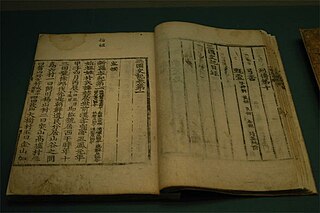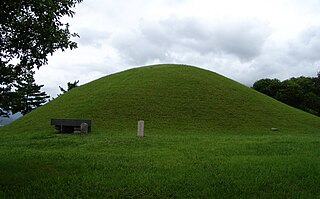Related Research Articles

The Kofun period is an era in the history of Japan from about 300 to 538 AD, following the Yayoi period. The Kofun and the subsequent Asuka periods are sometimes collectively called the Yamato period. This period is the earliest era of recorded history in Japan, but studies depend heavily on archaeology since the chronology of historical sources tends to be distorted. The word kofun is Japanese for the type of burial mound dating from this era.

Goguryeo, also called Goryeo, was a Korean kingdom located in the northern and central parts of the Korean Peninsula and the southern and central parts of Northeast China. At its peak of power, Goguryeo controlled most of the Korean peninsula, large parts of Manchuria and parts of eastern Mongolia and Inner Mongolia.

Samguk Sagi is a historical record of the Three Kingdoms of Korea: Goguryeo, Baekje and Silla. The Samguk Sagi is written in Classical Chinese, the written language of the literati of ancient Korea, and its compilation was ordered by King Injong of Goryeo and undertaken by the government official and historian Kim Busik and a team of junior scholars. Completed in 1145, it is well known in Korea as the oldest surviving chronicle of Korean history. The document has been digitized by the National Institute of Korean History and available online with Modern Korean translation in Hangul and original text in Classical Chinese.
Muryeong of Baekje was the 25th king of Baekje, one of the Three Kingdoms of Korea. During his reign, Baekje remained allied with Silla against Goguryeo, and expanded its relationships with China and Japan.

Baekje or Paekche, also called Nambuyeo, was a Korean kingdom located in southwestern Korea from 18 BC to 660 AD. It was one of the Three Kingdoms of Korea, together with Goguryeo and Silla.
Uija of Baekje was the 31st and final ruler of Baekje, one of the Three Kingdoms of Korea. His reign ended when Baekje was conquered by an alliance of the rival Korean kingdom Silla and China's Tang dynasty.
King Mu of Baekje (580–641) was the 30th king of Baekje, one of the Three Kingdoms of Korea. He was the 4th son of King Wideok.
Goi of Baekje was the eighth king of Baekje, one of the Three Kingdoms of Korea.
Jinsa of Baekje was the sixteenth king of Baekje, one of the Three Kingdoms of Korea.
Asin of Baekje was the seventeenth king of Baekje, one of the Three Kingdoms of Korea.
Jeonji of Baekje was the eighteenth king of Baekje, one of the Three Kingdoms of Korea.
Guisin of Baekje was the nineteenth king of Baekje, one of the Three Kingdoms of Korea. He was the eldest son of King Jeonji and Lady Palsu.
Buyeo Pung was a prince of Baekje, one of the Three Kingdoms of Korea. He was son of the last king, Uija of Baekje. When Baekje fell to the Silla–Tang alliance in 660, he was a hostage who mortgaged the alliance of Baekje with Japan. He was shortly unofficially proclaimed king.
Bojang of Goguryeo was the 28th and last monarch of Goguryeo the northernmost of the Three Kingdoms of Korea. He was placed on the throne by the military leader Yeon Gaesomun. His reign ended when Goguryeo fell to the allied forces of the southern Korean kingdom of Silla and the Chinese Tang Dynasty.

Chumo, posthumously Chumo the Holy, was the founding monarch of the kingdom of Goguryeo, and was worshipped as a god-King by people of Goguryeo. Chumo was originally a Buyeo slang for an excellent archer, which became his name later. He was commonly recorded as Jumong by various Chinese literatures including history books written by Northern Qi and Tang—the name became dominant in future writings including Samguk Sagi and Samguk Yusa. Chumo's title was changed to Dongmyeong the Holy, literally translated to the Bright Holy King of the East, at some point of time prior to compilation of Samguk Sagi (1145). His other names include Chumong, Jungmo, Nakamu, or Tomo. In Samguk Sagi, he was recorded as Jumong with the surname Go, and was also known as Junghae or Sanghae.
Ono no Imoko was a Japanese politician and diplomat in the late 6th and early 7th century, during the Asuka period.

Jinpyeong of Silla was the 26th king of the Silla Dynasty, one of the Three Kingdoms of Korea. King Jinpyeong followed in the footsteps of his predecessor, King Jinji, by reorganizing the central ruling system of Silla. Upon the onset of a multitude of conflicts between Baekje and Goguryeo, he sent emissaries to improve relations and strengthen ties between Silla and the Chinese dynasties Sui and Tang. He is also known for his promotion of Buddhism as a spiritual guide for the kingdom and encouraging Buddhist teachings.
Yeongyang of Goguryeo was the 26th monarch of Goguryeo, the northernmost of the Three Kingdoms of Korea. He was the eldest son of Pyeongwon of Goguryeo.
Buyeo Gonji was a member of the royal family of Baekje, one of the Three Kingdoms of Korea. He was a son of the 21st king, Gaero of Baekje and younger brother of the 22nd king, Munju of Baekje.
References
- ↑ Book of Sui. Beijing: Zhonghua Book Company. 1997. ISBN 9787101003161.
- ↑ Nihon Shogi. Iwanami Shoten. 1994. ISBN 9784003000410.
- ↑ Samguk Sagi. 박이정. 2004. ISBN 9788978786959.